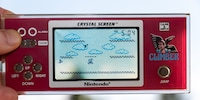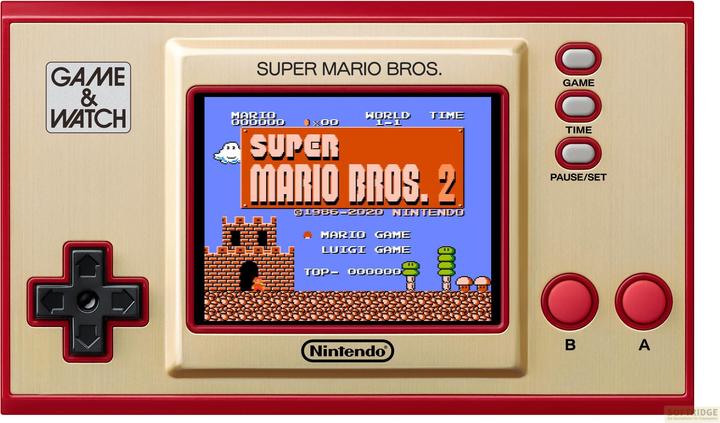

Game&Watch - a journey back to childhood
In the new Game&Watch from Nintendo, two childhood memories merge into one for me. When I think back to the original games of the early 80s, I realise that the concept was brilliant.
Yes, I got hold of one of those new Game&Watch things. But only on the second try.

I reckon that almost all buyers were born in the 70s or early 80s. For everyone else, Nintendo's Game & Watch games are just small devices that beep. Useless, boring, superfluous. For me, they are magic.
Childhood memories
I was six or seven years old when I discovered "Donkey Kong Jr." at my uncle's house. It was the first time I had ever played a computer game. I crawled into a corner and was unresponsive for the rest of the day. At night, I dreamt of a jungle with lianas.
I was given the game as a birthday or Christmas present. I played it a lot. We went on a week's skiing holiday. It snowed non-stop, we never went skiing. I played Donkey Kong Jr. non-stop for a week. If I scored more than 999 points, the score started from zero again. After a while, I managed to do that three times in a row, even in the difficult B-game. But that was no reason to stop playing. At some point I realised that the device started to spin in a funny way if I took the batteries out very briefly during the game and put them back in again immediately. Anything was possible: playing with several characters at the same time, permanently dying without the game ever being finished, enemies that were far too fast or standing still. What happened was pure chance.
I think I would still be really good at this game today. The moves are etched in my long-term memory. When I look at the video above, I know exactly where I would play differently. Sometimes the player takes too long to get to the top, which is a massive point deduction. And he should throw the coconut so that it hits three times. That's 3+6+9 points. You can also jump directly in front of a bear trap if you're fast enough ...
Unfortunately, I no longer have Donkey Kong Jr. After years I got bored of it, so I swapped it for another game. It wasn't from Nintendo and I got bored of it after a short time. In general, I think Donkey Kong Jr. is one of the best games of its kind.
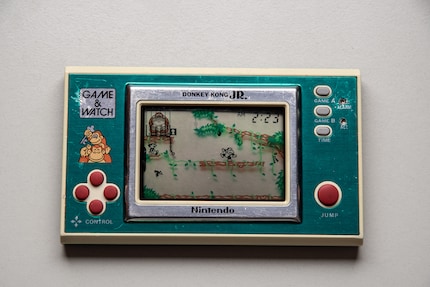
Addition, 7 December 2020: I found the game again in my parents' house and after a little cleaning inside it's running again. An almost 40-year-old device, runs without any problems. What I didn't remember: At 300 points, the errors are deleted, and if you haven't made an error until then, the points count double until the next error.
The new Game&Watch has the same typical design of the old games. So it immediately triggers the nostalgia reflex. Super Mario Bros. is played on it, another childhood memory. I didn't have the NES myself, but I often played it at friends' houses. Here's a comparison between old and new, using the example of Octopus (1981), which also matches in colour:
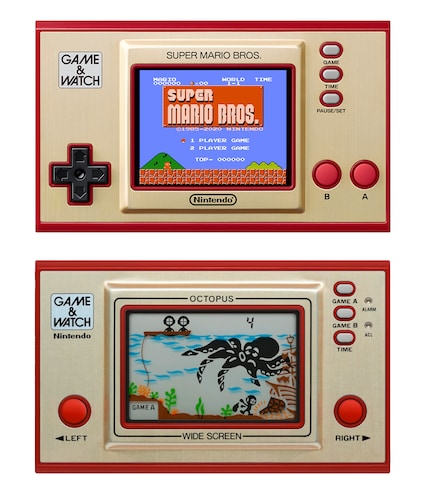
Genius low tech
The new Game&Watch emulates the NES games Super Mario Bros. and Super Mario Bros. 2. Inside is a cheap ARM processor - a Cortex M7 with 1.4 MB RAM and 280 MHz clock frequency. The device has a normal colour display.
The screens of the old Game&Watch devices, on the other hand, are anything but normal from today's perspective. They have no pixels; instead, the figures are engraved directly into the screen as liquid crystal moulds. Although the figures are monochrome, they are very finely drawn. And because only one game can be played, the scenery is painted in colour behind the screen. A kind of stage set.
This may seem primitive from today's perspective, but it was actually very clever. Because on an ordinary screen, the computer has to calculate every single pixel. In LCD games, an entire figure corresponds to one pixel. There are therefore far fewer possible combinations that the computer has to calculate.
This scene with three objects requires the same amount of effort as three pixels.
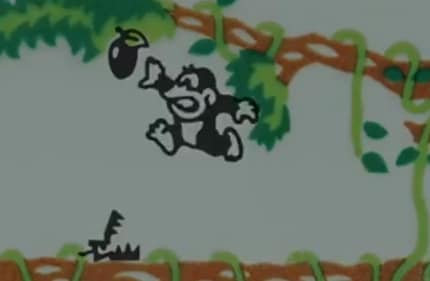
This was the only way it was even possible to build portable games consoles in the early 1980s. Not only that, they were really small, light, cheap and energy-efficient. In comparison, the first Game Boy from 1989 was a giant block that lacked any elegance.
The screens have no backlighting. Similar to an eBook reader today, they therefore require practically no power. The two small button batteries last forever.
This is why these games are never switched off. When you're not playing, a demo is running. Adding a clock to the game makes sense in this case. And an alarm clock. In Donkey Kong Jr. it's Mario who rings the bell. Otherwise, Mario just sits on the sidelines and watches the goings-on.
In the new Game&Watch, the screen cannot remain switched on because it has to be illuminated. Nevertheless, when you press the power button, the time is immediately displayed, just like on a smartphone in standby mode. But the alarm clock is missing.
I think it would be really cool if Nintendo released a Game&Watch with old technology. Nostalgia is the only reason to buy anyway, so why not go the whole hog?
My interest in IT and writing landed me in tech journalism early on (2000). I want to know how we can use technology without being used. Outside of the office, I’m a keen musician who makes up for lacking talent with excessive enthusiasm.
Interesting facts about products, behind-the-scenes looks at manufacturers and deep-dives on interesting people.
Show all